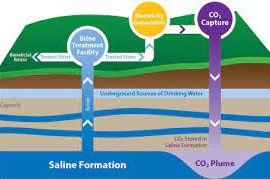
The state proposes carbon capture to get rid of what this plant is fuming out of their stacks. Bob Marshall says not too fast!
If your neighbor started a backyard business that was producing fumes known to pose fatal health effects for your family, which of these proposals would you support: A) Make him stop and find a job that doesn’t threaten your future or B) Let him continue while he develops some way of capturing the dangerous fumes and storing them somewhere, all the while still producing those fumes. Now you understand the debate behind using carbon capture and storage (CCS) as a government-funded tool to quickly reduce greenhouse gas emissions before the sea level rise they are causing drowns the word’s coastlines, including most of Louisiana’s. This debate is about to take center stage in Louisiana for several reasons. Our coastal master plan concluded that if world emissions are not dramatically reduced over the next decade, there’s little chance of saving what’s south of I-10, a population and business hub.
nola.com
Carbon capture is option B. The emissions continue and we bury them underground. It is what industry favors.
Our state ranks in the top five for total emissions nationally due to the petrochemical plants located here that have a big impact on our economy. Carbon capture and storage is a main plank in Gov. John Bel Edwards’ Climate Action Plan, a first of its kind in the Deep South. It was unanimously approved by the diverse task force which created it. That group included representatives from the petrochemical sector. After years of refusing to accept responsibility for their major role in creating the climate problem (an effort still underway), trends in world markets and investments have them seeing the future. The worldwide move to renewable energy for everything from home heating to cars means sales will only go down. Carbon capture collects carbon in smokestacks or during the production cycle. It would then be stored underground either on land or offshore in locations from which oil and gas were previously extracted. The Gulf of Mexico has been touted as the best possible location, and the industry and state are pushing that as a concept to employ workers laid off by the decline in offshore oil and gas. CCS advocates say it could prevent the collapse of highly polluting industries important to current economies and lifestyles, such as cement (alone responsible for a third of world carbon emissions) and petrochemicals.
Carbon capture has a lot of supporters from the President on down and thus is in the nations quiver of possible actions.
Even some leading agencies and researchers on the climate crisis consider carbon capture an important tool. The Intergovernmental Panel on Climate Change endorsed it, the International Energy Agency says it could reduce 15% of all carbon emissions. Even President Joe Biden believes in it. His infrastructure legislation last year included $12 billion for CCS projects, the largest amount ever given. So, what could possibly be wrong with spending billions and years on CCS? Plenty, say its opponents.
My first objection is 15% reduction. Is that all? We need more!
The best presentation on the dangers is a recent report, “The False Promise of Carbon Capture as a Climate Solution in Louisiana and Beyond” by The Center for Progressive Reform, co-authored by Rob Verchick and Karen Sokol, Loyola University law professors. Large scale carbon capture hasn’t even been proven to work. Billions in taxpayer support for the few large projects have ended in failure. No one knows what effects pumping hazardous emissions into the ground will have on aquifers — many of which are already declining due to warming caused by those same emissions. Some carbon capture ideas include converting them to a fluid and then using that for fracking new oil and gas wells — basically producing more of the products that result in more emissions requiring more capture. Such carbon fluids stored underground must be monitored for safety for thousands of years. This by an industry that has abandoned hundreds of thousands of polluting wells across the nation, which taxpayers are now spending billions to take care of.
And so what is the bottom line? Renewable only? Produce and use carbon capture? What?
My bottom line right now? Sure, invest in exploring CCS but not at the expense of moving faster on systems we already know work and don’t create even more emissions, such as solar, wind and green hydrogen. And I keep thinking of that first example. Why keep allowing an industry that caused the problem to keep producing it — and at our expense?
Good ideas and maybe carbon capture will work but the threat of damaging aquifers is enough to put me off.



